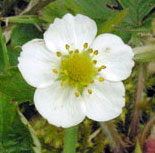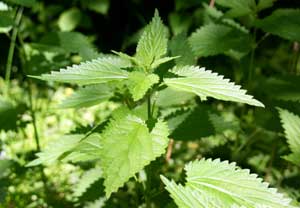Wild food

Collecting food from the wild is definitely something to take advantage of if you have the opportunity to do so and I am sure many people have at least gathered blackberries from the wild.
Summer and autumn are both excellent times for wild fruit. These can be munched straight from the plant or made into a variety of puddings, drinks or jams. I have found all of the following in woodlands:
- Cherries
- Wild Strawberries
- Raspberries
- Blackcurrants and Redcurrants
- Bilberries
- Gooseberries
- Blackberries
If you can beat the squirrels to them, Hazelnuts, Walnuts and Chestnuts are very good nuts for collecting.
You may come across many plants in and around woodlands that are edible - I have listed some of my favourites below. When collecting, an obvious point is to be sure you have correctly identified what you are picking, this is especially important with mushrooms! There are some very good books available to help you do so (e.g. "Food for free" by Richard Mabey).
Hairy bittercress (Cardamine hirsuta)
This is often found growing in the winter months when there is little else available. Good in sandwiches and salads.
Sorrel (Rumex acetosa)
Often used by the French in sauces, these lemony flavoured leaves make a good addition to salads, and also a good soup.
Wild Garlic/ Ramsons (Allium ursinum)
Delicious finely chopped with cream cheese, in tomato dishes and as a soup.
 Stinging Nettle (Urtica doica)
Stinging Nettle (Urtica doica)
A good spinach substitute - full of vitamins. Tasty with mashed potato. Good in soups, Lasagne and stews.
Watercress (Rorippa nasturtium-aquaticum)
One of my favourites. Be sure to collect from fast flowing water as it can be host to Liver Fluke. Very good in salads and soups.
If you are collecting leaves always try to cut or pinch them off, leaving the roots intact.
A Recipe for Sorrel/Ramsons/Nettle/Watercress soup:
- Two good handfuls of Sorrel/ Ramsons/ Nettle or Watercress
- Onion
- 2 potatoes, chopped
- good knob of butter
- salt and pepper
- cream to taste
Chop and fry the onion in the butter. Add potatoes, cover with water and boil till almost tender.
Add greens right at the end and cook until wilted (couple of minutes). Blend in food processor, season and add as much cream as you like!
Comments are closed for this post.
Discussion
I love wild garlic and the seasonis approaching. Does anyone know anywhere in or near London where one can pick it?
Oh, nearly forgot! The bible of wild food is “Food For Free” by Richard Mabey. It is required reading for anyone interested in wild food. It isn’t a field guide however, so you will want one of those as well, just to avoid any confusion over correct identification.
The sorrel referred to above, rumex acetosa, is a wild version of French sorrel. It is related to dock. The wild version is called sheep’s sorrel.
The three-leaved plant known as wood sorrel, the one like a shamrock, is oxalis acetosa. It is not related to sheep’s sorrel or garden sorrel, but shares a similar flavour.
Neither is poisonous and both are good to eat. However, they both owe their sour flavour to the presence of oxalic acid. This makes them unsuitable for those with rheumatic problems, kidney or bladder stones, pregnant women and very young children, all of whom should eat sorrel only sparingly.
Wood sorrel is a much less common plant than sheep’s sorrel, so sheep’s sorrel makes a better choice of wild food IMO. Both are good food though, as an addition to salads, for sorrel soup (very nice) or to act as a foil for fatty meat or oily fish.
So is that French sorrel or wood sorrel, the one that look like a shamrock, more interested in eating the latter? Is that ok or poisonous?thanks
I`ve just discovered a lovely little book called “A Hedgerow Cookbook” by Gleenie Kindred. Tracey it does has a small section on nuts and seeds, not too many recipes but well worth a look.
Thats one thing I miss about the countryside is picking the wild foods, my mum used to live in a place called Talysarn (near Dorothea quarry) and in the summer time there are whole hillsides covered with wild strawberries, its amazing I’ve never seen anything like it anywhere else before.
Excellent, thank you for this we have a large wood behind our house, the children and I now spend a lot more time over there gathering food (not much gets back home).
Thanks for the recipe John – it looks great!
Hi, you can also make nettleade
1 hatfull of nettle tops
450 gram/ 1lb brown sugar or honey
1 orange
1 lemon
3/4 cookpot full of water
1) put nettle tops and sugar in the cookpot add the water and simmer for 15 minutes
2)cut orange and lemon in half and squeeze into cooling liquid
then add the squeezed halves
3)when cool strain and enjoy
you can also make
gorseade,cloverade,cowslipade,dandelionade,elderberryade,and elderflowerade
[…] first shots of young nettles, Urtica dioica, are very good for cooking both soups (see recipe in wild food post) and tea. According to several sources it is also good nutrition, and a source of iron, calcium and […]
Sorry, just seen it is Jade who wrote this one…… sorry to call you Margaret!
Tracy
Hi Margaret
Me again! Can you recommend a recipe book for preparing some of these foods? (or have you written one!?)
We do have Food for Free…. we would like to know things like how to bake with chestnut flour etc! Have you tried it?
Tracy
In the U.K. wild blackberries can be harvested even in quite urban locations. Going berry-picking wasn’t what I expected to do when moving to London but it turned out to be lots of blackberry around :-)


Frenette, I live in Brittany and and have been given a bottle of frenette an alcoholic/wine drink, made from Ash, I can’t find out which part of the Ash it’s made from [ would guess young leaves] can anyone help please
Penny
11 December, 2009